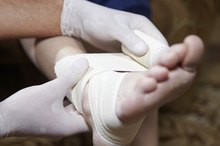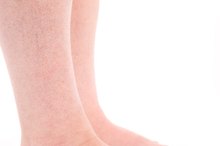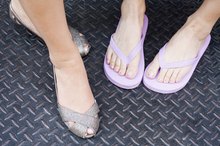Why You Have Heel Pain After Playing Basketball
If you suffer heel pain from playing basketball, the cause could be a variety of issues 3. Anything from improper footwear and inadequate pregame stretching to plantar fasciitis and even poor running technique may be behind your condition. If the pain is significant or persists for more than a couple of days, don't hesitate to contact a medical professional. Heel pain needs to be taken seriously.
If you are experiencing serious medical symptoms, seek emergency treatment immediately.
Simple Causes
Recreational athletes commonly experience heel pain for reasons that are correctable without surgery. Heel pain can stem from insufficient stretching or training before a game, scrimmage or open gym session. It may also derive from actively participating in basketball after a long period of inactivity. You could be simply playing more basketball than your feet can handle at the moment, resulting in an overuse injury, such as a muscle strain in your heel. Visit a podiatrist if the pain persists. Rest without medical care can lead to inflammation of the soft tissue in your heel and create undue stress on your heel bone itself.
- Recreational athletes commonly experience heel pain for reasons that are correctable without surgery.
- Heel pain can stem from insufficient stretching or training before a game, scrimmage or open gym session.
Running Technique and Foot Issues
Vitamin D Deficiency & Plantar Fasciitis
Learn More
Heel pain can also stem from poor running technique or issues with your feet. For example, some people run with "flat feet." Hitting the ground with your heel first puts extra stress on your joints, your arch and your heel bone. Your feet should hit the ground with the balls of your feet to lessen the force on your heels and improve your speed. Some instances of heel pain result from an injury elsewhere that your feet compensate for, causing undue stress on your heels. Other foot conditions that may produce heel pain are arthritis, psoriasis, gout, tumors, heel spurs and nerve damage.
- Heel pain can also stem from poor running technique or issues with your feet.
- Some instances of heel pain result from an injury elsewhere that your feet compensate for, causing undue stress on your heels.
Plantar Fasciitis
One of the most common causes of heel pain is plantar fasciitis, or an inflamed plantar fascia 3. The plantar fascia is a confluence of tissue in the sole of your foot that supports your arch. Plantar fasciitis is triggered by overstretching the plantar fascia, producing tiny tears in the fibrous tissue of the fascia, particularly at the point where the fascia conjoins with the heel bone. Basketball, volleyball and tennis players are likeliest to experience plantar fasciitis, especially if wearing shoes that don't support the feet. Athletes are especially susceptible to plantar fasciitis when they push themselves beyond their normal training regimen.
- One of the most common causes of heel pain is plantar fasciitis, or an inflamed plantar fascia 3.
- Basketball, volleyball and tennis players are likeliest to experience plantar fasciitis, especially if wearing shoes that don't support the feet.
Heel Spur
What Causes Sore Feet in the Morning After Exercise
Learn More
Like plantar fasciitis, a heel spur is a common cause of heel pain in recreational basketball players. A heel spur is an irregular bone growth. It occurs at the spot where the heel bone connects with the plantar fascia. Strain on the muscles of your foot and your plantar fascia triggers this condition. Like with plantar fasciitis, it can be exacerbated by playing basketball in ill-fitting or worn-out shoes, and in some cases it is brought on by plantar fasciitis. Again, always consult a doctor for the final word.
- Like plantar fasciitis, a heel spur is a common cause of heel pain in recreational basketball players.
Related Articles
References
- Pro Support Systems: Heel Pain
- Health Central: Heel Pain
- Bulls.com: Ask the Docs: Heel Pain
- American Academy of Orthopaedic Surgeons. OrthoInfo. Plantar Fasciitis and Bone Spurs. Updated June 201.
- UptoDate. PLANTAR FASCIITIS RISK FACTORS. Updated September 13, 2018.
- Cardenuto ferreira R. Talalgia: plantar fasciitis. Rev Bras Ortop. 2014;49(3):213-7. doi:10.1016/j.rboe.2014.03.012
- Ang TW. The effectiveness of corticosteroid injection in the treatment of plantar fasciitis. Singapore Med J. 2015;56(8):423-32. doi:10.11622/smedj.2015118
- Article titled "Joint Mobilization and Stretching Exercise vs Steroid Injection in the Treatment ofPlantar Fasciitis: A Randomized Controlled Study" by D Celik and co-authors published in Foot & Ankle International in 2015.
- Article titled "Treatment Outcomes of Corticosteroid Injection and Extracorporeal Shock Wave Therapy as Two Primary Therapeutic Methods for Acute Plantar Fasciitis: A Prospective Randomized Clinical Trial" by M Mardani-Kivi and co-authors published in The Journal of Foot & Angle Surgery in 2015.
- LeBlond RF, Brown DD, Suneja M, Szot JF. The Spine, Pelvis, and Extremities. In: LeBlond RF, Brown DD, Suneja M, Szot JF. eds. DeGowin’s Diagnostic Examination, 10e. New York, NY: McGraw-Hill; 2015.
Writer Bio
Jeff Smith spent eight years as a reporter and sports editor before working for 15 years as a copywriter and editorial manager at Awana, one of the world's largest children's ministries. Today he operates Write for Your Cause, an editorial service, and writes sports articles for the "Daily Herald."








